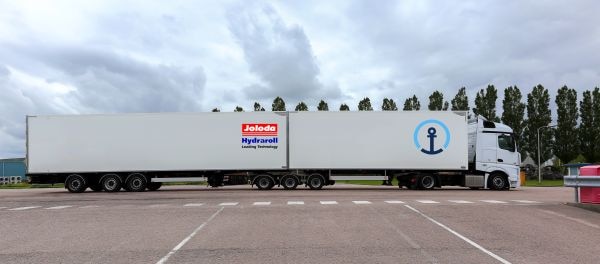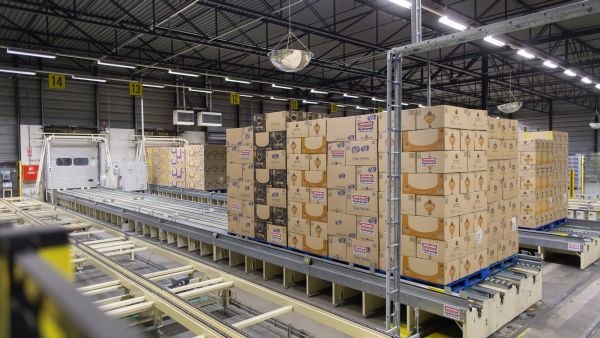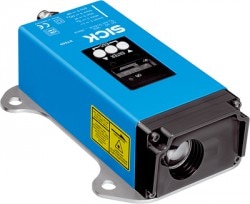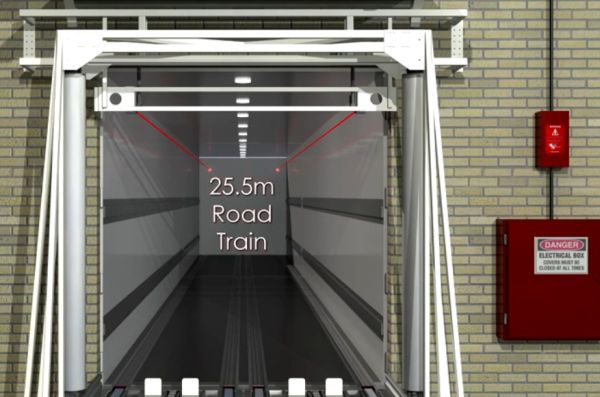Where there used to be manned forklift trucks driving about loading truck trailers with boxes of chips, the new Joloda loading system pushes 42 pallets into an extra-long truck in one fully automated operation. Time saved: An entire 30 minutes. The new Flat Floor Trailerskate Dock flexible loading system is the result of close collaboration between Joloda, the loading specialist, PepsiCo, the food group, Kühne + Nagel, the logistics provider, and Heiwo, the truck manufacturer. Installed as standard: Sensor Intelligence from SICK.
 PepsiCo loading bay
PepsiCo loading bay
Speed is the key competitive advantage in the world of fast moving consumer goods, accelerated by e-commerce. That is why companies are always searching for new ways of automating operational processes to meet the requirements of 'just-in-time' philosophy. A prime example is PepsiCo's fully automated loading system at Broek op Langedijk in the Netherlands.
 EuroCombi extra-long truck
EuroCombi extra-long truck
Reduced loading time
The PepsiCo loading bay is buzzing with activity. Normal trailers and extra-long trucks are constantly being loaded and unloaded here. They are used for the shuttle to the Kühne + Nagel warehouse in Utrecht, says Wouter Satijn, Sales Director at Joloda Group. The extra-long trucks (also known as EuroCombis) have a 21.5 m load bed - big enough for 42 pallets. The driver just has to connect his EuroCombi to the loading bay control system, and the loading system does the rest, explains Satijn.
Distance measurement allows for flexibility
In the warehouse everything is geared towards 'just-in-time' processing: The automated palletizer system ensures the individual boxes are placed in perfect alignment on the pallets. Each pallet is then taken to the Joloda automatic dock. Wouter Satijn explains, The pallets are arranged in three groups: 16 pallets, then 10, then 16 again on the Trailerskate conveyor.
 Automated palletizer system
Automated palletizer system
 DT500 long range distance sensor
DT500 long range distance sensor
When the roller gate on the auto dock opens, two bracket-mounted SICK DT500 long range distance sensors come down. They measure the depth of the trailer and check whether the trailer is correctly equipped. Distance measurement is crucial, because normal 13.6 m trailers are loaded and unloaded here as well as the extra-long EuroCombis: It is important to Kühne + Nagel to be able to decide at the last moment whether whatever trailer is nearby should collect a load from Broek op Langedijk. Satijn continues: If the SICK sensors detect a depth of 13.6 m, then 16 plus 10 pallets can be loaded into the vehicle. If they detect a depth of 25.5 m, the system pushes all 42 pallets into the loading tunnel of the EuroCombi.
 DT500 long range distance sensors with red laser measure the depth of the trailer
DT500 long range distance sensors with red laser measure the depth of the trailer
Gliding smoothly with compressed air
The actual loading of the trailer uses the risor plate technology developed by Joloda. Satijn: The stationary auto dock and the trailer each have a system with compressed air hoses under the rails. While there is no air in the hoses, the rails lie slightly lower than floor level. Then, when compressed air is introduced, the risor plates rise to floor level. On the rails there are long skates on which the pallets lie. Satijn continues: The compressed air makes the pallets float a few centimeters above the conveyor and allows them be moved into the truck. Once the pallets have reached the correct position in the trailer, the pressure in the hoses is dropped and the rails sink back below floor level.
 Four PBS pressure sensors from SICK located in the box below the load bed
Four PBS pressure sensors from SICK located in the box below the load bed
 Above: four PBS pressure sensors
Above: four PBS pressure sensors
SICK technology fulfills an important role here, too. Four PBS pressure sensors monitor not only the pressure while the pallets are being lifted, but also the reduction in pressure. This ensures that the skates are not retracted until the system is no longer pressurized, says Satijn.
More space, more safety
The automated loading system saves an enormous amount of space in comparison to the use of manned forklift trucks: Space which can now be used flexibly for other purposes. This also improves safety at work and personal protection. In addition, there is hardly any mechanical load on the trailers because of the compressed air lifting system. It is very important to us that all of the details satisfy our quality requirements. We only want the very best. That also applies to components we purchase from third parties. This is why we choose reliable market leaders such as SICK. Plus, it is a great advantage that SICK thinks proactively when problem solving, summarizes Wouter Satijn.
- Product information: DT500 long range distance sensor, PBS pressure sensor
- Product portfolio: long range distance sensors, pressure sensors
- Customer information: Joloda, PepsiCo, Kühne + Nagel, Heiwo

